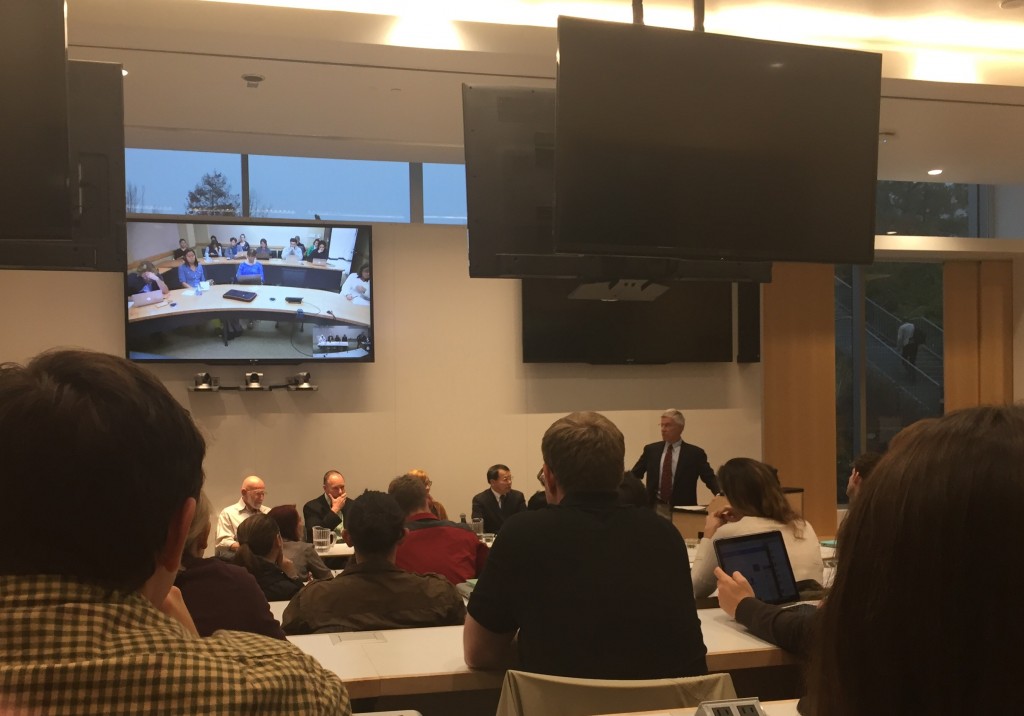The first of the Provost’s Forum on Conservation and Health was held on Tuesday, 1 December 2015. Sponsored by the Provost’s Office and the Duke Tropical Conservation Initiative, the panel discussed the conflicts between satisfying human needs while maintaining biodiversity in protected areas.
Field Auditorium was packed, with students seated on the steps and lining the sides just to listen to the experts from around the world. Moderated by Dr. Jeffrey Vincent, the panel included: Dr. Jiangou (Jack) Liu, University Distinguished Professor, Michigan State University; Dr. Patricia Wright, Distinguished Service Professor, Stony Brook University; Dr. David Wilkie, Director of Conservation Measures, Wildlife Conservation Society; and Dr. Michael Soulé, Professor Emeritus, University of California at Santa Cruz.

Dr. Vincent kicked off the session outlining the current state of growing biodiversity loss. Protected areas have been viewed by many as a panacea, preventing further land conversion and unchecked exploitation of natural resources. However, the establishment of protected areas have often resulted in the displacement of indigenous communities, infringing on their rights. The Makuleke people and Kruger National Park, the various Native American tribes and Yellowstone National Park – these are but the few most prominent examples of groups disadvantaged by contended land ownership during the creation of protected areas. Particularly in tropical areas, dense rural populations depend heavily on access to natural resources in forests that support a rich variety of wildlife. Conservationists face the difficult task of balancing human needs while trying to attain conservation goals.
Dr. Soulé emphasized that having people in parks was not intrinsically bad. After all, the biomass of humans and their domesticated livestock far exceed that of wildlife. Rather, the impact of human presence depends on the population stability, what and how resources are being used, the level of technology available. He suggested that people can utilize resources from protected areas without endangering biodiversity. However, the extent of their activities may have to be constrained. For example, while concessions can be made for them to hunt sustainably, clearing of land for farming would negate the conservation benefits.
Dr. Wright drew on her experience in Madagascar, where 95% of its original forests and many of its unique, endemic species have been lost. Ecotourism was previously thought to be a silver bullet, bringing in up to $2 million a year for the local economy. However, while the people living outside the parks now benefited, conditions inside the park deteriorated as the booming tourism increased populations around the park rather than alleviating pressures on natural resources. Additionally, the redistribution of park entrance fees to the local community was not equal, with corruption stymieing its effectiveness.
Dr. Wilkie approached the issue by asking what makes an effective protected area in the first place. He proposed that large reserves focusing on the protection ecosystem processes rather than individual species was key. As conservation is only needed when resources are being overexploited, a loser will invariably exist. Community ownership of these large reserves by local populations can prevent both physical and economic displacement. However, the devolving of authorities to the lowest level in Community Based Natural Resource Management schemes must be backed up by authorities with arresting power to prevent the management of lands from falling into the hands of the lowest competence level.
Finally, Dr. Liu pointed out that while protected areas are important, they are often not fully protected. The exclusion of local communities often result in poaching by the people who have no alternative livelihoods. Rather, conservation plans should couple humans and nature to create an interactive feedback system where impacts on either side will be felt by the other. More innovative approaches to conservation are required, such as subsidy schemes for residents that depend on the state of the forests on their land.
Rounding up the question and answer session, the panelists gave their last remarks on what they were hopeful for: the increasing awareness of ecosystem services and need for long-term protection, the resilience of biodiversity and possibility of reforestation, the growing options of effect certification for responsible consumption, and the potential of youths to effect change.
Personally, I find that the issue of people and parks are often framed in a false dichotomy, where only one can prevail. But the social aspect of conservation is as important as the ecological part. One cannot hope for conservation of nature to succeed if the people who depend on it are ignored. It was inspiring to hear from these global experts on such an important issue, and while much remains to be done, there is hope.


Hope indeed… thanks for the review.